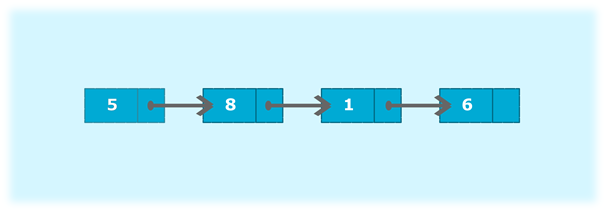Java从链表中查找最大值和最小值节点
在此程序中,我们需要在给定的单个链接列表中查找最小值和最大值节点。

我们将维护两个变量min和max。最小值将保存最小值节点,最大值将保存最大值节点。在上面的示例中,1将是最小值节点,8将是最大值节点。下面给出了找到最大和最小节点的算法。
算法
创建一个具有两个属性的类Node: data和next。下一个是指向列表中下一个节点的指针。
创建另一个具有两个属性的MinMax类: head和tail。
addNode()将一个新节点添加到列表中:
创建一个新节点。
首先检查head是否等于null,这意味着列表为空。
如果列表为空,头和尾都将指向新添加的节点。
如果列表不为空,则新节点将被添加到列表的末尾,以使尾部的下一个指向新添加的节点。这个新节点将成为列表的新尾巴。
a.minNode()将显示最小值节点:
定义变量min并使用head的数据对其进行初始化。
节点电流将指向头部。
通过比较每个节点的数据和最小值来遍历列表。
如果min大于当前数据,则min将保存当前数据。
在列表的末尾,变量min将保存最小值节点。
显示最小值。
a.maxNode()将显示最大值节点:
定义变量max并使用head的数据对其进行初始化。
节点电流将指向头部。
通过比较每个节点的数据与最大值来遍历列表。
如果max小于当前数据,则max将保存当前数据。
在列表的末尾,变量max将保存最大值节点。
显示最大值。
程序:
public class MinMax {
//Represent a node of the singly linked list
class Node{
int data;
Node next;
public Node(int data) {
this.data = data;
this.next = null;
}
}
//Represent the head and tail of the singly linked list
public Node head = null;
public Node tail = null;
//addNode() will add a new node to the list
public void addNode(int data) {
//Create a new node
Node newNode = new Node(data);
//Checks if the list is empty
if(head == null) {
//if list is empty, both head and tail will point to new node
head = newNode;
tail = newNode;
}
else {
//newNode will be added after tail such that tail's next will point to newNode
tail.next = newNode;
//newNode will become new tail of the list
tail = newNode;
}
}
//minNode() will find out the minimum value node in the list
public void minNode() {
Node current = head;
int min;
if(head == null) {
System.out.println("e92a358928984a70a0bbd869137986ee");
}
else {
//Initializing min with head node data
min = head.data;
while(current != null){
//if current node's data is smaller than min
//Then, replace value of min with current node's data
if(min > current.data) {
min = current.data;
}
current= current.next;
}
System.out.println("Minimum value node in the list: "+ min);
}
}
//maxNode() will find out the maximum value node in the list
public void maxNode() {
Node current = head;
int max;
if(head == null) {
System.out.println("List is empty");
}
else {
//Initializing max with head node data
max = head.data;
while(current != null){
//if current node's data is greater than max
//Then, replace value of max with current nodes data
if(max < current.data) {
max = current.data;
}
current = current.next;
}
System.out.println("Maximum value node in the list: "+ max);
}
}
public static void main(String[] args) {
MinMax sList = new MinMax();
//Adds data to the list
sList.addNode(5);
sList.addNode(8);
sList.addNode(1);
sList.addNode(6);
//Display the minimum value node in the list
sList.minNode();
//Display the maximum value node in the list
sList.maxNode();
}
}
输出:
Minimum value node in the list: 1
Maximum value node in the list: 8

